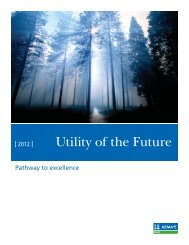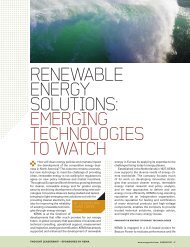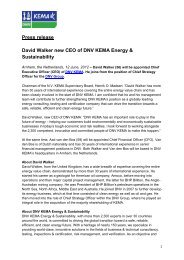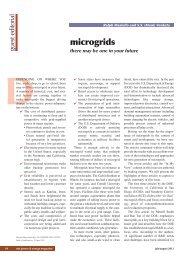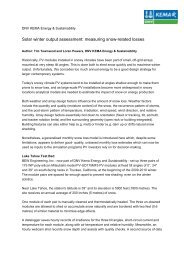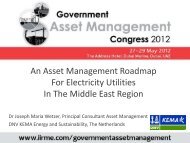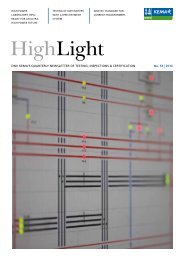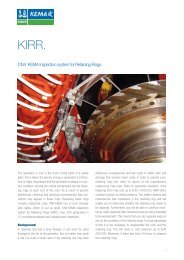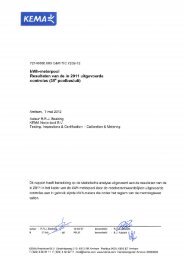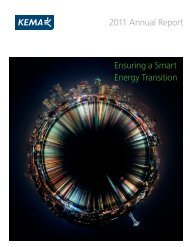Smart Grid Projects - DNV Kema
Smart Grid Projects - DNV Kema
Smart Grid Projects - DNV Kema
- No tags were found...
You also want an ePaper? Increase the reach of your titles
YUMPU automatically turns print PDFs into web optimized ePapers that Google loves.
2Contentsn <strong>Smart</strong> <strong>Grid</strong><strong>Smart</strong> <strong>Grid</strong> Interop Lab 3<strong>Smart</strong> Energy Collective 5PowerMatching City II 7The U.S. Navy Advanced Metering Infrastructure 9Preparing the future of power networks in the Netherlands 11Demand response equipment and customer education 13Exploring microgrid deployment in India 15Open public extended network metering 17KEMA <strong>Smart</strong> Cable Guard ® 19Active distribution networks 21Verification, integration and testing of PLC 23Flex Power <strong>Grid</strong> Laboratory 25Intelligent distribution station 27
3<strong>Smart</strong> <strong>Grid</strong> Interop LabVerifying the <strong>Smart</strong> <strong>Grid</strong>As new vendors and products enter the <strong>Smart</strong> <strong>Grid</strong> market, interoperability issues presentsignificant challenges. In this environment, utilities and manufacturers require greatercertainty that their technologies will work together.ProjectKEMA has developed a solution — the <strong>Smart</strong> <strong>Grid</strong> Interop Lab. The lab, which is locatedbehind the Duke Energy Envision Center in Erlanger, KY, offers independent verification ofdevice interoperability and compliance validation of low-voltage automation devices, metersand consumer products.ObjectivesTesting procedures focus on four key areas of interoperability performance: reliability,optimization, regression testing to ensure compatibility with older components, and cyber security.
5<strong>Smart</strong> Energy CollectiveAn industry initiative to accelerate innovations in smart energyThe <strong>Smart</strong> Energy Collective (SEC) is an open innovation initiative, with 30 industry partnersat present along the entire energy value chain, to accelerate innovations in smart energy.The partners range from TSOs, DSOs, energy suppliers and trading companies to service andtechnology providers, financial institutions, installation companies and energy consultancyfirms.Objectivesn To develop, design and build five field trials with a few thousand energy consumers atvarious locations in the Netherlandsn To apply different combinations of innovative scalable and interoperable smart gridtechnologies, products and services
6n To demonstrate and test these technologies for a period of at least 2 years under real-lifeconditionsn To validate the business case for smart energy based on data acquired from these fieldtrialsn To present results to the industry, the public, policy makers and others interested in smartgridsn To develop a common market for smart energy services with sufficient volume to makethis an attractive business for all partnersResults 2011The SEC was founded in late 2010 and the first phase regarding the establishment of theSEC has been completed. It resulted in a plan and a vision of how to construct five coherentfield trials in the Netherlands that could help to develop a consistent view of fully integratedsmart energy solutions. These field trials will cover all relevant end-user groups ranging fromindustry to offices and residential customers in various energy infrastructures (all-electric,gas & electricity, district heating). The planning for phase 2, the design phase, will befinalized by the end of 2011.Project coordinatorn KEMA, the NetherlandsProject partnersABB, Alliander, APX-ENDEX, Delta, Draka, Eneco, Enexis, Essent, GasTerra, GasUnie, GEN,Heijmans, Humiq, IBM, Imtech, Itron, KEMA, KPN, Logica, Miele, Nedap, NXP, Philips, Priva,Rabobank, Siemens, <strong>Smart</strong> Dutch, Stedin, TenneT and Unica.Project detailsn Primary funding: private investment by industry partnersn Subsidy: IPIN – Dutch government (expected)n Duration: September 2010 – September 2015
8ObjectivesThe second phase, PowerMatching City II, will focus on the development and demonstrationof business models for new services. New propositions will be offered to the end-user, basedon real-time pricing. The market model of PowerMatching City will be integrated into regularenergy market processes like allocation, reconciliation and billing. Capacity management andcontrol of a distribution station will be demonstrated by scaling up the living lab environmentto 50-75 households and extending the number of electric vehicles with smart chargingservices. The business case of the smart grid solutions will be validated based on theoutcome of PowerMatching City II.In addition, an open innovation platform will be created, allowing third parties to test anddemonstrate their innovative technologies and smart grid solutions in a real-lifedemonstration environment, thereby accelerating the innovation process.Project coordinatorn KEMA, the NetherlandsProject partnersn Humiq, the Netherlandsn Enexis, the Netherlandsn Essent, the Netherlandsn TNO, the Netherlandsn Gasunie, the Netherlandsn Delft University of Technology, the Netherlandsn Eindhoven University of Technology, the Netherlandsn Groningen University of Applied Sciences, the NetherlandsProject detailsn Subsidy: IPIN – Dutch governmentn Duration: September 2011 – September 2014
9The U.S. Navy AdvancedMetering InfrastructureTo meet requirements set forth by the Energy Policy Act of 2005 (EPAct05) and the EnergyIndependence and Security Act of 2007 (EISA07), the ‘Commander, Naval InstallationCommand (CNIC)’ assigned the NAVFAC Engineering Service Center (ESC) to plan andexecute an Advanced Metering Infrastructure (AMI) program across 120 naval bases at 10Navy regions worldwide.ProjectNaval Facilities Engineering Command (FEC) worked with URS (Washington Group) and KEMAto carry out a global site survey of selected regions, and develop the necessary documents,such as Function Requirement Specifications (FRS). The team also developed the pilot effortto install more than 200 advanced meters at the Naval Base Ventura County (NBVC) in thebuildings with high consumption. The AMI project uses the ‘Navy’s Public Safety Network(PSNet),’ a network transmitting data with the advanced Multiprotocol Label Switching
10(MPLS) technology. Inside each base, the communication network to transmit data frommeters to the DAS (the local area network) is designed as a hybrid network of wired andwireless solutions.ObjectivesThe U.S. Navy made the decision to implement advanced electric, water, gas, and steammeters to capture the top 95 percent of the consumption at each base, and exceed thecongressional minimum requirements by collecting the data at least once every 4 hours fromelectric meters, and once every 24 hours from mechanical meters.BenefitsDeployment of an advanced metering infrastructure for the U.S. navy has had its uniquechallenges from both technical and project-management perspectives. Some of theseinclude working with naval regions around the world with various metering practices andelectric service standards; dealing with more than 100 different utilities that provide energycommodities such as electricity, water, natural gas and steam to the navy bases; DoD’srigorous security and safety rules and regulations such as the requirement to use a wirelessintrusion detection system (WIDS); DoD’s stringent requirements on information assurance(IA) such as data encryption; quality assurance (QA); avoiding potential power outages atnaval critical loads; avoiding any wireless interference with activities such as missile tests;and the Navy’s aggressive requirements to save energy.ResultsDeployment of advanced metering infrastructure projects have been awarded to three MAC(multi-award contract) contractors - American Systems, Square D (Schneider Electric), andWeston Solutions - in six naval regions. Award of the project in the Midlant and Marianasregions is scheduled for the current fiscal year, and award of the EURAF-SWA and Far-Eastregions is planned for the next fiscal year. KEMA assisted the Navy to review the deliverablessubmitted by the contractors and their quality of work in deployment of the system.Project partnersn KEMA, URS, American Systems, Square D (Schneider Electric) and Weston Solutions(all partners are from the United States)
11Preparing the future of powernetworks in the NetherlandsTransition Roadmap Energy Infrastructure in the Netherlands (TREIN)The local energy infrastructure will undergo quite a few drastic changes in the near future.Decentralized renewable energy (such as solar modules on rooftops and micro CHP units)will be introduced and electric vehicles, HVAC systems and electrical heat pumps will resultin changes in the consumption patterns flowing through our networks. Most of the powerflows will not be planned, but induced by nature or by consumer demand (‘prosumers’).A prerequisite for successful integration of new supply and demand (and subsequent lowerenergy cost and reduced CO 2emission) is that the network be capable of supporting thesechanges. New investments in infrastructure, cables and equipment (local production andstorage) therefore have to consider these developments, while at the same time consideringregulatory limits. The TREIN project addresses these issues from technical, economic andsocietal perspectives. In the end, a number of real-life experiments should provide proof forthe lessons learned. Such experiments will be organized in the program ‘InnovatieProgramma Intelligente Netten’ (IPIN).
12TREIN is developing a number of tools, including those to generate future energy demandprofiles for households and to estimate the large-scale economic effect of decentralizedpower production for the Netherlands. Business simulations in a FleXdis environment willprovide insight into the influence of infrastructure user behavior (the behavior of developers,operators and households) and the interaction with regulation. Finally, the project should leadto ideas on how authorities can shape the energy transition through (additional) policyinstruments.ProjectKEMA has contributed in the following activities:n Power model, heat model and calibration of energy profilesn Stakeholder researchn Research on the behavior and comments of prosumers and grid operatorsn Preparation of grid experiments with stakeholders and partnersObjectivesThe main objective is for AgentschapNL to obtain the required background to design andevaluate experiments in smart grids. Tools have been prepared to generate energyconsumption and production patterns. Insight has been gained into the cost and value ofprosumption and AgentschapNL has a clear view of the expectations and requirements ofactors and stakeholders in the field.Clientn AgentschapNL, the NetherlandsProject coordinatorn Eindhoven University of Technology, the NetherlandsProject partnersn CPB Netherlands Bureau for Economic Policy Analysis, the Netherlandsn Alliander, the Netherlandsn KEMA, the NetherlandsProject detailsn Duration: January 2007 – June 2012
13Demand response equipmentand customer educationNorthWestern Energy (NWE) <strong>Smart</strong> <strong>Grid</strong> Demonstration ProjectThe NorthWestern Energy <strong>Smart</strong> <strong>Grid</strong> Demonstration Project is a part of the larger PacificNorthwest <strong>Smart</strong> <strong>Grid</strong> Demonstration Project. The objective is to test emerging new HomeArea Network technologies on a select group of customers to see how they will be received.Specific types of end uses will be connected and tracked so that the utility can find out whattypes of end uses customers are willing to shut down during demand events, and how muchopportunity there is for shedding residential electric loads. This will also be a first test ofTime of Use rates for NWE customers.Participants will be surveyed at several points during the two year pilot to determine howthey feel about the system, how it is working for them, which features they use, and whichones they don’t. Neighborhood meetings are also being considered to bring participantstogether in such a way that they can discuss their perceptions of the program andexperiences about how they use their system.
14ProjectNorthWestern Energy, Tendril and KEMA will be teaming up to connect approximately twohundred local utility customers to the <strong>Smart</strong> <strong>Grid</strong>n NWE will be installing auto capacitors and regulators on three main substation feedsn Tendril will provide HAN (Home Area Network) equipment including in-home displays, aweb portal, where consumers can learn about and manage their energy usage, and theirsoftware platform Tendril Connect, on which all systems communicate. Tendril is alsoproviding marketing services to help enroll NWE customersn Lockheed Martin’s SEEsuite <strong>Smart</strong> <strong>Grid</strong> Command and Control platform will providedemand response management and integrated situational awarenessn Itron is supplying its CENTRON® R300 advanced residential metersn KEMA will install the HAN equipment in the customer’s home and educate them on its useThis type of integration will allow customers to receive real-time data informing them ofdemand response events, providing management of kWh usage, and permit remote controlof any device or appliance that is connected to the Home Area Network. It is the first projectof its type in Montana. In the past, HANs have been either shipped to the customer for selfinstall, or installed by an HVAC technician or electrician.Benefitsn NWE customers will now have a choice as to what they pay for electricity based on thenew time of use rates. They will have a new perspective on purchasing electricitn KEMA will utilize its extensive experience with residential in-home services to providecustomers with one-on-one training on the system and its features and functionsn The utility has a system for meeting high demand situations, and the information aboutwhat amount of demand response they can expect when a event is scheduledClientn Tendril, USAn NorthWestern Energy, USAProject coordinatorn KEMA, USAProject detailsn Duration: 2011- December 2014
15Exploring microgriddeployment in IndiaWith demands for electric power in India growing at a faster pace than the construction ofelectric power infrastructure and new generation sources, many Indian companies areapprehensive about their ability to obtain enough reliable, ready energy from the grid so thatthey can effectively run their businesses.Larsen & Toubro (L&T) is a large technology, engineering, and construction company withoffice campuses located across India. Over the past several years, L&T has experiencedmultiple extended power outages and in response has built enough back-up generation tomeet its needs in the event of an outage. However, these diesel-based backup units useexpensive fuel, and the costs and logistics to transport diesel to sites make operational costseven greater. With the growing ability to harness wind and solar power, as well as the Indiangovernment’s impetus, L&T wanted to explore the costs and benefits of deploying microgridsas a means of ensuring self-sustaining electrical power in a more economical manner.
16ProjectL&T was interested in deploying microgrids at its facilities in Chennai and Kanchipuram,which combined had 6,000 hours in power outages last year, as pilot projects with thepossibility of expanding microgrid deployment to other sites. L&T engaged KEMA to explorewhat factors would make the business case for deploying these microgrids viable. KEMAworked with L&T to identify what factors would enable a viable business case. Using thisinformation, KEMA customized its cost-benefit analysis model to L&T’s specific businessneeds and considered various deployment scenarios. KEMA considered how factors such asIndia’s young renewable energy credit (REC) market, solar panel subsidies and otherdiscounts, and energy tariffs, as well as equipment mix would affect L&T’s overall businesscase. We also studied L&T’s investments and cash flow for a 30-year period to determine theviability of microgrid deployment over the long term. KEMA also developed a Microsoft®Excel-based model that enables users to vary the set of inputs, including current discountrates; REC values; buyer rebates; energy tariffs; and fuel, capital, and outage costs, to seethe effects on the cost-benefit ratio for each set of variables.ObjectivesMicrogrid deployment is a relatively new technology concept in the power industry. There arevery few live commercial microgrid sites in the world, and there are some risks. Thetechnology is not fully tested in India, so L&T needed to understand the key cost-benefitfactors of deploying microgrids to justify the initial investment.BenefitsKEMA’s analysis determined that microgrid deployment is a viable proposition for L&T. Theviability of its business case will enable L&T to not only expand its own microgrid operationsbut also to showcase its microgrid as a demonstration project for customers interested inbuilding microgrids using L&T’s construction services. By building its own microgrid, L&T willachieve significant energy savings and lessen its reliance on grid power.Clientn Larsen & Toubro, IndiaProject coordinatorn KEMA, United StatesProject Detailsn Duration: September 2011 – November 2011
17Open public extendednetwork meteringOPEN MeterProjectThe OPEN Meter project is strongly aligned with the smart metering standardization mandategiven by the European Commission to the European Standardization Organizations, CEN,CENELEC and ETSI. The project aims to remove a perceived barrier to the wide-scaleadoption of smart metering in Europe, by ensuring that the requirements for smart meteringcan be met by products and systems that are based on open, international standards toensure interoperability and that are accepted and supported by the widest possible circle ofstakeholders.ObjectivesThe main objective of the OPEN Meter project is to specify a comprehensive set of open andpublic standards for AMI, supporting electricity, gas, water and heat metering. This set ofstandards will be based on the agreement of all relevant stakeholders in this area, and take
18into account the real conditions of the utility networks so as to allow for full implementation.The project will result in a set of draft standards based on existing and accepted standardswherever possible. These standards include the IEC 61334 series of PLC standards, the IEC62056 DLMS/COSEM standards for electricity metering, and the EN 13757 series ofstandards for utility metering using M-Bus and other media. These existing standards will becomplemented with new standards based on innovative solutions developed within theproject to form the new body of AMI/smart metering standards. The resulting draft standardswill be submitted to the European and international standardization process.Objectivesn To address the regulatory issues concerning AMI/smart metering in various Europeancountries and identify the requirements of the various stakeholdersn To review the state of the art of the various technologies available, including protocols forwired, power line carrier and wireless communication media, as well as application datamodels and system architecturesn To carry out the necessary research and development activities to ensure that therequirements of AMI/smart metering can be met in a cost effective mannern To develop test approaches and procedures for laboratory, compliance and field tests.Actual tests will be carried out on newly developed system elementsn To consolidate the results of the previous items and provide a formal specification of thestandard. The results will be submitted to the relevant European and internationalstandardization bodiesn To specify how the results of the project will be used and disseminated to allstakeholders, utilities, manufacturers, energy market participants and end usersProject coordinatorn Iberdrola, SpainProject partnersn 18 partners from 8 countries (including KEMA)Project detailsn EU Seventh Framework Programn Duration: January 2010 – July 2013
19KEMA <strong>Smart</strong> Cable Guard ®Continuously monitoring the ‘heartbeat’ of an MV cable connectionWe take the energy supply for granted, but how reliable is it? Blackouts show us howvulnerable we are if the energy is not there. For affected businesses, power failures can haveserious economic consequences. If the IT systems go down, for example, the cost can easilyrun into millions. In recent years, major failures have hit places such as New York, Londonand Italy, bringing daily life to a complete standstill.Medium-voltage networks are crucial to the energy supply. However, many of the MVnetworkscurrently in use are aging and/or have weak spots, such as joints and terminations,which increase the blackout risk. To address this risk, network operators can performpreventive checks in the form of periodic off-line snapshots. Such precautions are valuable,but a problem affecting a joint or cable can build up to a critical level within just days orweeks. So the only way to assure prompt intervention is through continuous monitoring.
20ProjectKEMA has introduced a unique, innovative system called KEMA <strong>Smart</strong> Cable Guard ® , whichcontinuously listens to the ‘heartbeat’ of an MV cable by monitoring and locating partialdischarge activity. At each end of the cable, a sensor and a control unit are installed tomeasure partial discharge (PD) activity along the entire length of the cable connection whileit is in use. The measurements are sent by GPRS to KEMA’s control center, where they areanalyzed and interpreted. When critical PD values are detected, details of the defect’slocation are sent to the network operator, with advice about what should be done.The network operator can then take precautionary action, such as redirecting the power orplacing a generator set to secure the supply before doing the necessary repairs. In this way,the operator can avoid the adverse media reports, unhappy customers and possiblecompensation claims liable to result from a blackout. A continuous flow of information aboutthe condition of the cable network also provides the owner with a foundation for optimizedreplacement and maintenance strategies and efficient risk management. It also meanspreviously unavailable insight into the behavior of MV cables and accessories.Benefitsn Continuous access to MV network status informationn Early warnings and advice about appropriate actionn Indicative distance-to-defect informationn Reduction and distribution of maintenance costsn No need to interrupt power during installation or daily usen Prevention of negative publicity and claim reductionn Public image enhancement: innovative and reliable grid managementProject coordinatorn KEMA, the NetherlandsProject partnersn Alliander, the Netherlandsn Eindhoven University of Technology, the Netherlandsn Enexis, the Netherlandsn Stedin, the NetherlandsProject detailsn Duration: 2005 – Ongoing
21Active distribution networksAddressIn the smart grids of the future, there will be a growing need for demand to play a moreactive role in power systems (Active Demand – AD). There will also be increasing consumerconcern about environmental and energy efficiency issues. In this context, ADDRESS aims todevelop a comprehensive technical and commercial architecture to enable AD among smallcommercial and domestic consumers, and to exploit the benefits of AD.ADDRESS is expected to contribute to the achievement of flexible, reliable, accessible andeconomically efficient grids by enhancing consumers’ flexibility. The exploitation of thisflexibility will permit the achievement of more reliable operations by proposing solutions toremove commercial and regulatory barriers for the full integration of distributed andrenewable generation, thus supporting sustainable energy consumption.
22ProjectAfter setting up a theoretical framework, the parties involved have created the technical andhousehold systems, the communication systems involved with the Energy Box, the marketinformation systems and the integration of the network operators in the Scada/EMS system.Currently, manufacturers are producing and testing prototypes of the new components. All ofthese components will then be linked together and tested, both in labs as well as in the field(France, Spain and Italy).ValidationThat’s where KEMA comes in. KEMA manages the team that is responsible for examiningwhether all of the components do what they promise to do, not just as individualcomponents, but primarily as parts of the complete system (system aspects). To validate thesystem, simulation tests will be set up in the laboratory and carried out in accordance withthe manufacturers’ specifications. The final proof will be to test the ADDRESS solution atthree sites with different circumstances (meteorological, cultural, etc).Project coordinatorn ENEL Distributione, ItalyProject partners:n EDF-SA, Francen Iberdrola, Spainn ABB, Switzerlandn University of Manchester, UKn KEMA, Netherlandsn University of Cassino, ItalyOther partnersTecnalia, Landis & Gyr, Ericsson, Alcatel, Philips, ZIV, Electrolux, University of Comillas, VTT,VITO, Vattenfall, University of Sienna, RLTec, CTI, Consentec, ENEL I&I, UK Power Networksand DobrogeaProject detailsn Partners from 11 countriesn EU Seventh Framework Programn Duration: July 2008 – June 2012
23Verification, integrationand testing of PLCDLC+VIT4IP: technologies and IP communication for utilitiesModern utility communication demands a platform that can provide the flexibility formulti-application communication for smart grid protocols. Such a platform not only offers thenecessary interoperability to select equipment for networking and applicationsimplementation but also supports tomorrow’s smart grid applications like management ofdistributed generation, or video surveillance and facility access control.Within the European project DLC+VIT4IP, the Internet Protocol (IP) is used in combinationwith narrow-band PLC to meet these criteria. The goal is to optimize power utilitycommunication and offer flexibility and lean communication down to the field level of a utilitygrid. The emphasis is on information security – a focus issue for the Electric Power Utilities(EPUs) over the last ten years. As providers of vital products and services, EPUs need todevelop new security systems and procedures that reflect the improvements in (ICT) and alsorecognize the development of malicious and other types of threats.
24ProjectDLC+VIT4IP is using the Internet Protocol to develop and verify a high-speed, narrow-bandPLC infrastructure, which is capable of supporting existing applications and extending new,multiple communication applications. On the application side, the IP is increasingly used inmany supervisory and control application fields, including the energy sector. The approach isused for the existing power distribution network and for novel services in smart electricitydistribution networks (e.g., demand-side management, control of distributed generation andcustomer integration). The solution developed by the project will be verified in test fields. Theproject is expected to yield a prototype for a high-performance communications infrastructure,simulation and planning tools, and testing and conformance rules to enable applicationdevelopers and users to choose appropriate technologies for their needs. Many of theseproducts will be used for standardization.Project coordinatorn KEMA, the NetherlandsProject partnersn Austrian Academy of Sciences, Austrian Devolo, Germanyn Israel Electric Corporation, Israeln HW Communications, United Kingdomn iAd Gesellschaft für Informatik, Automatisierung und Datenverarbeitung, Germanyn Lancaster University, United Kingdomn Technische Universität Dresden, Germanyn Consortio per la Ricerca nell’Automatica e nelle Telecommunicationi (UoR), Italyn Yitran Communication, Israeln Vlaaamse Instelling voor Technologisch Onderzoek, Belgiumn Vattenfall Europe Netzservice, GermanyProject detailsn EU Seventh Framework Programn Duration: January 2010 – December 2012
25Flex Power <strong>Grid</strong> LaboratoryInnovative testing and model validation of DER equipmentThe Flex Power <strong>Grid</strong> Lab (FPG Lab) in Arnhem is an independent, medium-voltage laboratoryequipped for testing and researching innovative control and (grid-connected) powerelectronics under complex realistic conditions. The FPG Lab is capable of supplying industrialmedium-voltages (400 V – 24 kV) at a continuous high-power rating (1 MVA), in combinationwith complex realistic ‘bad grid’ conditions, including pre-programmable distortion(harmonics or dynamic network phenomena up to 2.4 kHz). This facility is one of the fewcapable of ascertaining whether distributed energy resource (DER) units function correctlyunder realistic system conditions. It verifies the hardware (power components) and thecontrols (ICT) simultaneously to validate that a DER unit is ready to be integrated into a largersystem (e.g., the energy grid). The FPG Lab is the only facility able to test such combinationsat medium-voltage and high-power levels.
26ObjectivesThe FPG Lab already enables clients to realistically testn Whether their distributed generation equipment will interfere with grid performancen (Distributed generation) equipment under severe future grid conditions to ensureefficiency and proper functionalityn Whether the grid will operate reliably and stably under extreme circumstances (highpenetration of certified DGs)n The ability of filters and conditioners to compensate for inconsistencies and protect loadsn Possible abnormal equipment responses to simulated grid events.Benefitsn Ensures the effectiveness of new controls and operating guidelines prior to full-scaledeployment, avoiding lost man-hours and negative returns on capital expenditure, thuspreventing losses that could potentially increase to thousands of eurosn Drastically shortens DG integration time and facilitates market introduction by testing forcompliance with standards such as EN50438, EN50160, IEEE 1547, BDEW (FGW TR3),IEC 61683 and IEC 62116n Reduces field-testing time dramatically when integrating any type of new controln Prevents field installation surprises, preventing unplanned outages, lost productionincome, lost man-hours and negative publicityn Provides insight into the impact of high (certified) DG penetration levels on the grid andallows stability to be verifiedn Ensures compliance of filters and conditioners with site specificationsn Enables observation of equipment behavior under abnormal grid conditions KEMA usesthis facility to research and develop innovative solutions for future grid applications, suchas smart grids.Project coordinatorn KEMA, the NetherlandsProject partnersn Energieonderzoek Centrum Nederland, the Netherlandsn Delft University of Technology, the Netherlandsn Eindhoven University of Technology, the Netherlands
27Intelligent distribution stationDeveloping and testing a smart substationIncreased penetration by dispersed generating units and developments in power demandmay be expected to steadily increase the degree of fluctuation exhibited by the power flowsin low-voltage and medium-voltage distribution grids.ProjectThe aim of this project is to design an intelligent 400 kVA, MV/LV distribution station (intDS)that will allow power flow fluctuations to be managed while maintaining power quality,reliability and security of supply. A full-scale prototype was assembled and extensively testedat the Flex Power <strong>Grid</strong> Lab (FPG Lab). It was then installed in a live test grid as a pilot.ObjectivesThe objective of the project was to design and build a proof-of-principle intelligentdistribution station. The goal of creating such a station is to enable a subordinate low voltage
28grid characterized by a high degree of distributed generation penetration to be monitoredand controlled. The intelligent distribution station’s functions are in the fields of peak loadmanagement, improvement of reliability, supply of reactive power, power qualityenhancement and additional services.Benefitsn Control of voltage distortion, resulting in improved power quality levelsn Demand response, resulting in a more flexible and controllable gridn System for local control and remote monitoring, resulting in higher information levelsn Energy storage system, consisting of a battery and a bi-directional invertern Stepless control of the voltage level on the low-voltage bus barn Bi-directional communication between household appliances and the intDS using a homeautomation system, resulting in a more flexible and controllable gridKey resultsn The design, specification and realization of an intelligent distribution stationn Detailed knowledge of the (validated) control schemes appropriate for a wide range ofscenarios in smart low-voltage gridsn Laboratory proof of principle with field validationKEMA’s role was to perform the basic design and specification of the substation and to applyour innovative testing know-how to the proof of principle.Project coordinatorn ECN, the NetherlandsProject partnersn KEMA, the Netherlandsn Eaton Electric, the Netherlandsn Imtech Vonk, the Netherlandsn Exendis, the Netherlandsn Alliander, the Netherlandsn Alfen, the NetherlandsProject detailsn IOP EMVT Research Programn Duration: 2006 – 2010




